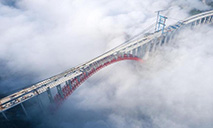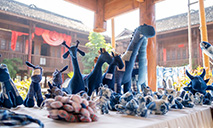Speech recognition software helps Tibetans better communicate
CHENGDU, March 17 (Xinhua) -- When away from home, Gerong, who speaks only Kamba Tibetan, a Tibetan dialect, often found himself in awkward situations where few people could understand him.
This month, however, when the 50-year-old Tibetan from Garze prefecture in Sichuan Province visited a hospital in the provincial capital of Chengdu, he communicated smoothly with a Mandarin-speaking doctor about his illness.
What helped them conquer the language barrier is a speech recognition app on the smartphone that can convert the three main Tibetan dialects -- U-Tsang, Amdo, Kamba -- to texts and translate them into Chinese.
The software, named the Dungkar Tibetan Keyboard, is the brainchild of a group of young engineers from iFLYTEK, an AI and speech-technology giant.
"With its new capability to recognize the Tibetan dialects, the software can now meet the needs of about two-thirds of all Tibetans across China," said Nyima Wangdu, product manager of Dungkar.
The Tibetan-language keyboard was first launched in 2017, but only began to support speech recognition early this month. It took the engineers nearly five years to enable the function after building a sufficient Kamba Tibetan corpus.
"The main obstacles in developing the software were a lack of a corpus and a lack of support from linguists on Tibetan dialects," said Nyima Wangdu.
To solve the problem, the group from iFLYTEK expanded the search for Tibetan dialect speakers. They enlisted nearly 60 Tibetan students from Southwest Minzu University to the project, who helped the team enrich the corpus of Kamba Tibetan.
On the technical side, the group set up a team dedicated to developing a new generation of versatile multilingual speech synthesis systems.
Cao Bin, one of the engineers, majored in linguistics in college. His work focused on tackling the syntactical differences between Tibetan and Chinese. For instance, he said, "March 13" is referred to as "13 March" in Tibetan.
Deng Qi, a user interface designer in the group, had to deal with the aesthetic issue arising from the difference in sentence lengths of the two languages.
"While we tried to make the lengths of the two languages match, we also worry about the accuracy of the translations," said Deng. "We made a great effort to achieve the ideal result."
Now, Dungkar has more than 4.8 million users in Tibetan-speaking regions such as Tibet Autonomous Region, and Sichuan and Qinghai provinces.
"I believe that language is not just a tool to communicate, but also a bridge that brings people in different places closer to each other," said Nyima Wangdu.
Photos
Related Stories
Copyright © 2022 People's Daily Online. All Rights Reserved.










